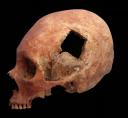 Holes cut into skulls in the Cuzco area indicate that trepanation was a relatively common practice for Inca surgeons, most likely as treatment for combat injuries.
Holes cut into skulls in the Cuzco area indicate that trepanation was a relatively common practice for Inca surgeons, most likely as treatment for combat injuries.
Interestingly, the skulls dating from 1000 A.D. show no evidence of bone regrowth which means the owners of said skulls died under the knife. They clearly didn’t give up, though, because by 1400 A.D. 90% of the skulls showed healing and no infection.
Of 411 skulls that were sufficiently well preserved to study, 66 had holes cut through the bone.
In one location, 21 of 59 skulls—over a third—had received trepanation.
While methods of trepanation varied over time, Inca surgeons eventually settled on a scraping technique to penetrate the skull without causing wider injury.
“The skull was slowly scraped away, resulting in a circular hole surrounded by a wider area of scraped bone,” Verushko said.
Some of the skulls had been perforated more than once, including one individual who had undergone the operation seven times.
Damn. Stop-loss much? 😮
I can think of a few things which might be a bit more painful than having your skull slowly scraped away … but not many.
They did have some good drugs, though. The Incas were familiar with the coca plant by then, so hopefully that dude who went back for 6 more skull scrapings wasn’t feeling too much pain.
Here is a link to a scientific paper by Andrushko and Verano entitled: Prehistoric trepanation in the Cuzco region of Peru: A view into an ancient Andean practice. The journal is: American Journal of Physical Anthropology.
Link to abstract here.
83% survival rate is pretty astounding.
That’s the study referenced in the article! I always forget I know people with special scholarly powers.
Ya, it’s really remarkable. I mean, surgery without infection in Europe was damn rare until the mid-19th century. Meanwhile, across the pond, the Incas were successfully fixing broken skulls 400 years earlier.